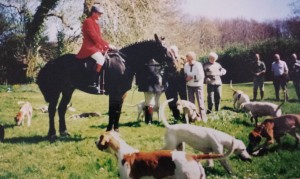“No one ‘cept a huntsman knows a huntsman’s cares”. The words of Mr Jorrocks are probably more relevant in these modern times than ever before. The calm appearance of a huntsman at he sits on his horse with his eager hounds on the ground around him at this season’s Opening Meet reflects little of his many worries and concerns for the ensuing day’s sport. We live in exciting and changing times and the modern day huntsman would probably laugh out loud when told that Tom Firr, the celebrated Leicestershire Quorn huntsman of the late 1800s, complained that hunt followers on bicycles were spoiling some of the hunting by inadvertently turning the fox on the Melton Mowbray road above the wood called Shoby Scholes.
However, the basics of the huntsman’s job, both in kennels and in the hunting field, has changed little over the centuries and most probably the great huntsmen of the modern era would have been equally successful in the glory days of yore. Weather, scenting conditions, modern farming practices, and Legislation are only problems to be surmounted, and the qualities of the hounds and the skills of their huntsman are such that good sport is still enjoyed by many packs in the 21st century.
There are no hard and fast rules to becoming a great huntsman. A person, man or woman, has to be born with something of a natural instinct, then experience, hard work and lifelong dedication should produce the finished article. Sounds easy!
The days of large numbers of staff employed in hunt kennels and stables have long gone, and a modern huntsman has to expect to get his hands dirty. Every hunt kennel is different and routines will vary. The numbers of staff, of hounds, of days hunted each week all have a bearing on how a kennel is run. The food and the method that hounds are fed varies greatly. Some Hunts have become Government DEFRA “collection points” and farmers’ dead stock is collected from a wide area for disposal. Others only have a DEFRA “end user license” which prohibits the collection of dead stock at all. There is no doubt that more time is taken keeping and up-dating Government records than ever before.
Since the 2004 Hunting Act came into force a huntsman has to be aware of what he is allowed to do with his hounds out in the hunting field. This isn’t as easy as it should be because even the legal profession have had problems interpreting this poorly drafted piece of legislation. So whether an exemption clause is to be used, or the hounds are to pursue a false trail, a huntsman has to be confident before he leaves the meet that he will have enough evidence to use in his favour should it be necessary to defend his actions in a court of law.
Preparation is the key to successful hunting, and this added to the skill of the huntsman, and a little luck, should lead to an Opening Meet and a hunting season being enjoyed by all. The hounds should be as fit as possible and weeks of summer exercise will pay dividends. Confidence between hounds and their handler out in the hunting field is of prime importance.
The Masters of the packs who have decided to follow a false trail will be trying to make the day seem as natural and as like an old fashioned hunting day as possible, with the hounds and the hunting being the focal point of the day. Where the pack is firstly taken to “draw” or search for a line is very important, and whether or not a trail has been laid at this place will leave the followers and the hounds guessing as to what is going to happen. A blank draw, where no line has been laid, can give hounds and horses chance to settle, and might not be such a bad thing. The focus should be on the hounds and their work . This illustrates one of the main differences in a days trail hunting to a days drag hunting, when the people who have paid money for an instant gallop on their horses on a drag hunt might well complain to the management should hounds have a blank draw!
A good way to end a false line is to stuff the trail down an old rabbit or fox hole, and when hounds reach the place they will “mark to ground” in much the same way as if a fox had been run to ground. Foxes might be viewed on a days trail hunting, and may even be seen crossing the line or going in a similar direction to that of the laid trail before hounds arrive. Likewise, deer, sheep, cattle or horses might also cross or follow the route the line has taken and their scent too will mask that of the trail. These are all problems for the pack and their huntsman to overcome.
As the daylight starts to fail towards the end of the day and it is time for hounds to go home, followers wish each other a “Goodnight” in the time honoured tradition. Weary, mud splattered riders, and car and foot followers will all happily reflect on an enjoyable day spent in the countryside, watching and hearing hounds hunting, and enjoying the company of their fellow hunters. Masters, the huntsman and staff, and the hounds will have done their best to produce a good day’s sport. When the repeal of the Hunting Act takes place packs will be ready to continue where they left off, and generations to come will continue to produce the great hounds and huntsmen of the future.

